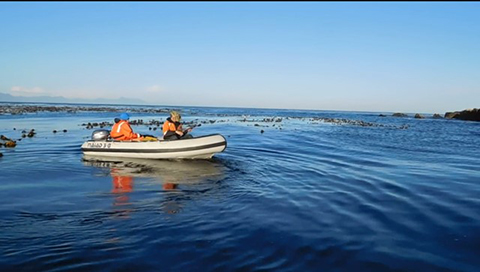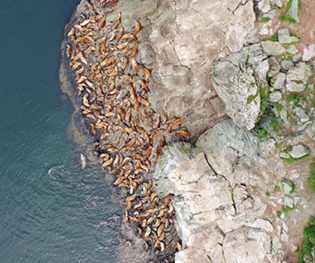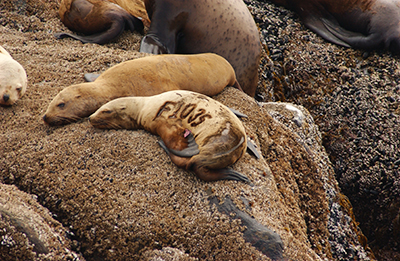Alaska Fish & Wildlife News
March 2024
Marine Mammal Mania
New Video Highlights Sea Lion Research

Darting massive Steller sea lions from a small inflatable raft on the outer coast of Southeast Alaska is highlighted in the first episode of Marine Mammal Mania.
The new series of short videos features the work of the Marine Mammal program at the Alaska Department of Fish and Game. The first episode, titled Age estimation for Steller sea lions using DNA methylation, looks at collecting tissue samples from adult Steller sea lions, using a special dart delivered by a crossbow. ADF&G biologists are applying genetic techniques to those samples to estimate a sea lion’s age – important in analyzing population data. Much of the sampling work has been done since 2018 at locations throughout the Gulf and Southeast Alaska including Kodiak and Prince William Sound as well as at Lowrie Island, part of the Forrester Island Wilderness in southern Southeast Alaska.
Wildlife biologists are generally eager to share their work with everyone curious about wildlife – but documenting what they do is difficult. They often work in remote locations in challenging weather, tucked in a small boat or aircraft loaded with gear. The timing of everything is unpredictable and the actual hands-on work with wild animals is done quickly and deliberately. Animal welfare is a priority, as is the safety of the researchers. It’s difficult to do the work and take pictures, let alone shoot video footage and record sound. There’s rarely room to accommodate a film crew – in the budget or in the field.

Last summer, marine mammal biologists were able do double (and triple) duty as scientists and filmmakers. Juneau-based biologists Barb Lake and Christi Bubac are producing the first episode of the series, working with their colleagues in the Marine Mammal program and Channel Films. Grants from the North Pacific Research Board helped fund the DNA collection project and the inaugural video.
“One of the grants from the North Pacific Research Board focuses on outreach,” said Lake. “Most grants only fund the actual research, this enabled us to do a bit more.”
Over the summer of 2023, they gathered existing footage taken opportunistically in the last couple years by biologists in the field, identified what would be needed to tell the first story, capitalized on opportunities to gather new footage, and wrote the script for the first episode.
New research tool is a filmmaker’s friend
A fundamental aspect of Steller sea lion research is counting and monitoring the animals at rookeries – rocky, surf-battered outcrops where hundreds of sea lions gather in early summer to mate and have pups. Animals are also counted throughout the year at haulouts, well-established locations where these social animals congregate. Biologists re-sight marked animals that they’ve been monitoring for decades, they document females and their pups, juveniles and the big territorial adult males called bulls. In 2023, state biologists began using drones to capture video and still images of these sea lion gatherings.
Rather than scrutinizing a chaotic mass of boisterous sea lions through binoculars from a hidden blind or a bobbing boat, the drone pilot flies the device over the area, shooting footage that can be used to assess the population - and contribute to a documentary.

“This was the first time we’ve used drones at Lowrie,” Lake said. “We were testing them - can we even get counts on rookeries using drones? Can we launch and retrieve from a boat? An experienced drone pilot, Shay Valentine from the Oregon Department of Fish and Wildlife, came up and worked with our drone pilot, Steve Lewis. They collected a lot of footage, testing out routes, height, and angles, which gave us stable and clear video of the rookeries and location we never had before.”
Future Marine Mammal Mania episodes will benefit from aerial scene-setting and overview footage. Some of this is what’s considered “B-roll” footage, supplemental but important.
Channel Films, based in Anchorage, provided professional insight and advice, sound and video editing, animation, narration, and other production work.
“It was not feasible for a crew from Channel Films to accompany us in the field, so they worked with what we could get and advised us on what was needed,” Lake said. “Telling the story, setting the stage, providing an overview of the scene and the activity, you need to get all that. Biologists might get some shots of an animal as they are working, but we need footage showing them working on the animal. That’s the footage that was missing.”
Co-producer Christi Bubac is experienced with biopsy sampling of grey seals at Sable Island National Park Reserve in Nova Scotia, Canada and was on the sampling crew. “She knew what we were looking for, what we had and what we were interested in getting,” Lake said. Bubac served as a biologist/cinematographer and helped her colleagues target additional footage they needed.

Bubac said documenting and sharing our work with a diverse audience is an important but sometimes overlooked component of wildlife research. With this project, it was feasible to borrow clips taken in the field for research and training purposes and use them to help create a fun outreach video.
Virtually all the footage was shot using iPhones. “You’re in a float coat on a rocking boat, it’s raining, you’ve got gloves on, and you’re trying to get your phone out…” Lake said 30-seconds of footage might be shaky, but the five seconds where everything stabilized and came into focus gave them what they needed. They gleaned the contributions from a half-dozen biologists and sorted through them for the best clips.
Bubac and Lake wrote the script. Wildlife educators with the Division of Wildlife Conservation and biologists with the Gulf and Bering Marine Mammal Program offered suggestions, and Channel Films created a draft video. “We worked with the draft video to continually improve it,” Lake said. “We used placeholder video to help dial in the sequences, and there were multiple re-writes to fine-tune the phrasing, improve word choices, and we shuffled clips when we discovered better placement.”
Lake said from the get-go, the goal was to make science accessible to the public, to find a balance between fun sea lion videos and getting in the weeds with epigenetics. She recalled their personal guidelines: “Know your audience – don’t use department or scientific jargon the general public isn’t familiar with. See it from the outside perspective. Use terms that explain what we do without leaving the audience behind. It was a tricky needle to thread, especially with a topic like DNA methylation.”

“Channel films reviewed what we had and helped us identify areas that needed more detailed explanation. It was their suggestion to record staff biologists explaining the work to break up the voice over with interview clips.”
Future episodes will feature other research projects including marine debris, tracking Steller sea lion movements with satellite tags and surveying harbor porpoises using aerial infrared imagery. Stay tuned for more to come as this series brings ADF&G research to you.
More on Marine Mammals
Steller sea lion species profile
Videos:
Using wildlife detection dogs to help determine ringed seal density
Entanglement of Steller Sea Lions in Marine Debris: Identifying Causes and Finding Solutions
Subscribe to be notified about new issues
Receive a monthly notice about new issues and articles.
